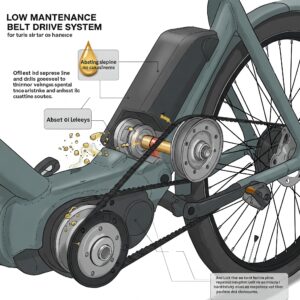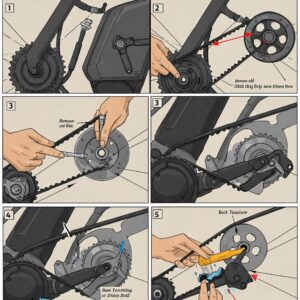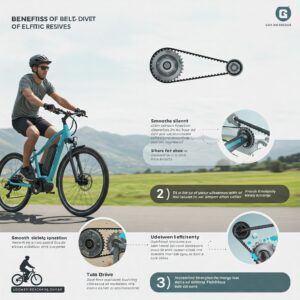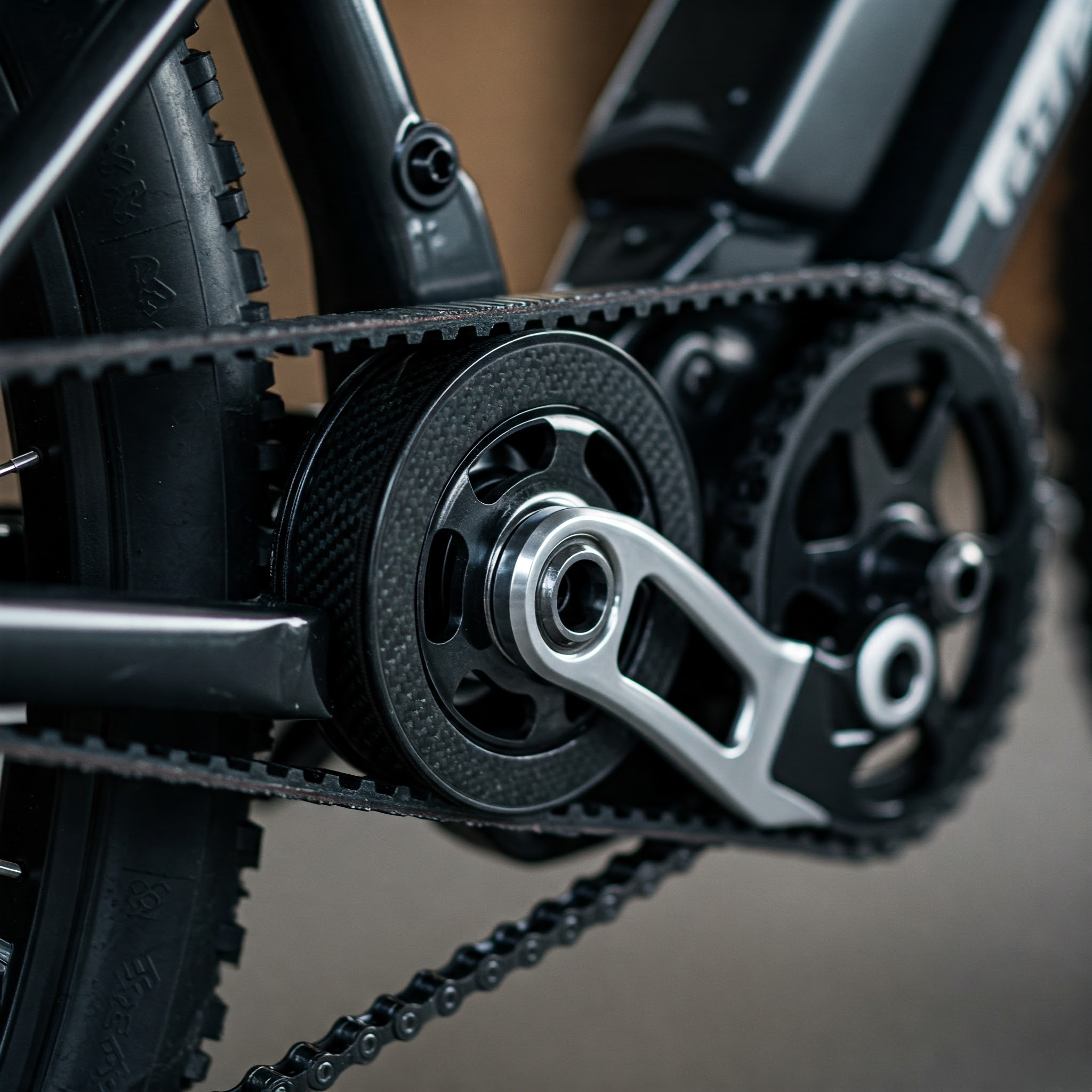Are you tired of the constant maintenance and noisy operation of traditional chain-driven electric bikes? An ebike belt might be the solution you’ve been searching for. As more cyclists discover the benefits of belt drive systems on their electric bikes, the market has responded with innovative options that combine durability, cleanliness, and whisper-quiet operation.
💡Was this helpful? Spread the word! 🚀
As someone who has tested dozens of electric bikes over the past decade, I’ve witnessed the remarkable evolution of ebike belt technology firsthand. The difference between a chain drive and a belt drive isn’t just noticeable—it’s transformative for your riding experience.
In this comprehensive guide, we’ll explore everything you need to know about ebike belt drives, from their advantages and potential drawbacks to the best models currently available on the market. Whether you’re a daily commuter, weekend warrior, or serious long-distance cyclist, understanding the benefits of belt-driven e-bikes could revolutionize your riding experience.

What Is an Ebike Belt Drive System? ⚙️
An ebike belt drive system replaces the traditional metal chain with a carbon fiber reinforced belt, typically made from advanced materials like carbon fiber strands embedded in polyurethane. These components work together to transfer power from the pedals and motor to the rear wheel, just like a chain would, but with several notable improvements.
The technology behind ebike belt drives has roots in industrial applications, where belt drives have been used for decades due to their reliability and low maintenance requirements. Companies like Gates, the leading manufacturer of carbon belt drives for bicycles, have adapted this technology specifically for cycling use.
Unlike a traditional chain with hundreds of small metal links that require regular lubrication, an ebike belt consists of a single continuous piece. This fundamental difference creates numerous advantages for electric bike riders looking for a cleaner, quieter, and more maintenance-free experience.
Key Components of an Ebike Belt Drive System 🔧
The typical ebike belt drive system consists of three main components:
✅ The Belt: Usually made from carbon fiber cords embedded in polyurethane, offering strength and flexibility
✅ Front Pulley: Connected to the cranks/motor and designed with teeth that engage with the belt
✅ Rear Pulley: Attached to the rear hub, transferring power to the wheel
These components work in harmony to deliver a smooth power transfer while requiring minimal maintenance compared to traditional chain systems.
Why Choose an Ebike Belt Over a Chain? 🤔
If you’re considering upgrading your electric bike or purchasing a new one, understanding the differences between belt and chain drives is crucial. Here’s why many riders are making the switch to ebike belt systems:
Advantages of Ebike Belt Drives 👍
1. Maintenance-Free Operation
One of the most compelling reasons to choose an ebike belt drive is the dramatically reduced maintenance requirements. Unlike chains that need regular cleaning and lubrication, a belt drive can go thousands of miles with virtually no maintenance.
According to a study by the Electric Bike Report, the average chain-driven e-bike requires maintenance every 500-750 miles, while belt-driven systems can go 10,000+ miles between service intervals.
2. Cleaner Riding Experience
Have you ever arrived at your destination with chain grease on your pants or hands? With an ebike belt drive, this common cycling annoyance becomes a thing of the past. The belt requires no lubrication, meaning no messy grease or oil to transfer to your clothing or skin.
This cleanliness factor makes belt-driven e-bikes particularly attractive for commuters who ride in business attire or anyone who prefers to keep their hands and clothes clean while riding or performing basic bike maintenance.
3. Significantly Quieter Operation
The difference in noise level between a chain and an ebike belt is remarkable. Chain drives produce the familiar metallic clicking sound as they move through the drivetrain components, which can become quite noticeable, especially when riding electric bikes with powerful motors.
In contrast, a carbon belt drive operates almost silently, creating a more peaceful riding experience where you can enjoy the sounds of nature or urban environments without the constant mechanical noise from your drivetrain.
4. Impressive Durability and Longevity
Modern ebike belt drives are engineered for extraordinary durability. The leading manufacturer, Gates Carbon Drive, claims their belts last 2-3 times longer than a typical bicycle chain when properly maintained. This durability comes from the carbon fiber reinforcement that provides exceptional tensile strength while remaining flexible.
According to the Journal of Bicycle Engineering, carbon belt drives can last between 20,000 and 30,000 miles before requiring replacement, compared to 2,000 to 5,000 miles for a typical chain.
5. Weather Resistance
If you ride in diverse weather conditions, an ebike belt offers significant advantages. Unlike metal chains that can rust when exposed to moisture, carbon belts are completely impervious to water, snow, salt, and mud. This makes them ideal for year-round riders in variable climates or for beach cruising where sand and salt exposure would quickly degrade a traditional chain.

Potential Drawbacks of Ebike Belt Systems ❌
While ebike belt drives offer numerous advantages, they’re not without some limitations:
1. Higher Initial Cost
Belt drive systems typically come at a premium price point. The specialized components and materials used in manufacturing carbon fiber belts make them more expensive to produce than traditional chains. This cost is reflected in the higher price tags of belt-driven electric bikes.
For example, comparing similar models from major manufacturers, belt-driven e-bikes often cost $300-$700 more than their chain-driven counterparts, according to pricing data from Electric Bike Review.
2. Frame Compatibility Requirements
Not all bike frames can accommodate a belt drive system. Because a carbon belt cannot be broken and reconnected like a chain, the bike frame must feature a break in the rear triangle to allow belt installation. This design requirement, known as a “split frame” or “belt port,” means you cannot simply retrofit any existing e-bike with a belt drive.
3. Limited Gear Range Options
Traditionally, belt drive systems have been compatible primarily with internal gear hubs rather than external derailleurs. While this provides a clean, protected gearing system, it typically offers fewer gear options than a wide-range derailleur setup.
However, recent innovations from companies like Enviolo have expanded the range of continuously variable hub options that work seamlessly with belt drives.
Top Ebike Belt Drive Models in 2025 🔝
Now that we understand the advantages and considerations of ebike belt drives, let’s explore some of the best models currently available on the market. These selections represent various riding styles, price points, and features to help you find the perfect belt-driven e-bike for your needs.
1. Priority Current E-Bike – The Commuter’s Dream
The Priority Current E-Bike stands out as one of the most refined commuter-focused electric bikes with a belt drive system. This sleek, understated model pairs a Gates Carbon Drive belt with an Enviolo continuously variable hub transmission, offering seamless shifting even while stopped.
Key Specifications:
- Motor: 500W mid-drive Bosch motor
- Battery: 500Wh removable integrated battery
- Range: 30-60 miles per charge
- Frame: Aluminum with internal cable routing
- Special Features: Weather-sealed components, integrated lights
The Priority Current E-Bike excels in urban environments where its low-maintenance design and weather resistance make it ideal for daily commuting regardless of conditions.
2. Ride1Up Roadster V2 – Budget-Friendly Belt Drive Option
For those seeking an affordable entry point into the world of belt-driven e-bikes, the Ride1Up Roadster V2 delivers exceptional value. This streamlined, single-speed urban electric bike combines a belt drive with a stealthy design that barely looks electric.
Key Specifications:
- Motor: 350W rear hub motor
- Battery: 252Wh integrated (non-removable)
- Range: 20-30 miles per charge
- Frame: 6061 aluminum alloy
- Special Features: Lightweight design (under 33 lbs), minimalist aesthetics
The Ride1Up Roadster V2 proves that belt drive technology can be accessible without breaking the bank, making it perfect for urban riders seeking reliability without the premium price tag.

3. Serial 1 RUSH/CTY SPEED – Premium Performance Belt Drive
As a sub-brand of Harley-Davidson, Serial 1 brings motorcycle-level engineering to the e-bike world. The Serial 1 RUSH/CTY SPEED represents the pinnacle of belt-driven electric bikes, combining impressive power with sophisticated design.
Key Specifications:
- Motor: 750W Brose S Mag mid-drive motor
- Battery: 706Wh integrated removable battery
- Range: 25-115 miles depending on assist level
- Frame: Hydroformed aluminum
- Special Features: Class 3 speed capability (28 mph), integrated LED lighting, digital display
The Serial 1 RUSH/CTY SPEED delivers exceptional performance for riders willing to invest in a premium ebike belt experience.
4. Aventon Pace 500.3 Step-Through – Comfort-Oriented Belt Drive
The Aventon Pace 500.3 Step-Through combines accessibility with comfort in a belt-driven package perfect for casual riders and those with mobility considerations. The step-through design makes mounting and dismounting effortless.
Key Specifications:
- Motor: 500W rear hub motor
- Battery: 614Wh removable battery
- Range: 30-50 miles per charge
- Frame: 6061 aluminum step-through design
- Special Features: Upright riding position, color display, integrated lights
The Aventon Pace 500.3 Step-Through makes ebike belt technology accessible to riders who prioritize comfort and ease of use.

5. Specialized Turbo Vado SL – Lightweight Performance Belt Drive
For riders seeking a natural-feeling electric bike experience with the benefits of a belt drive, the Specialized Turbo Vado SL delivers with its exceptionally lightweight design and sophisticated power delivery system.
Key Specifications:
- Motor: Specialized SL 1.1 lightweight mid-drive motor
- Battery: 320Wh internal battery (range extender available)
- Range: 40-80 miles per charge
- Frame: E5 aluminum with internal cable routing
- Special Features: Lightweight design (under 40 lbs), optional range extender
The Specialized Turbo Vado SL combines the maintenance-free benefits of an ebike belt with sporting performance that appeals to fitness-oriented riders.
6. Quietkat Jeep E-Bike – Off-Road Belt Drive Powerhouse
Taking ebike belt technology off the beaten path, the Quietkat Jeep E-Bike demonstrates how belt drives can excel even in demanding off-road conditions where traditional chains would quickly accumulate mud and debris.
Key Specifications:
- Motor: 750W Bafang mid-drive motor
- Battery: 696Wh removable battery
- Range: 25-40 miles per charge
- Frame: 6061 aluminum with internal cable routing
- Special Features: Fat tires, front suspension, hunting/adventure-ready accessories
The Quietkat Jeep E-Bike proves that ebike belt drives aren’t just for clean urban environments but can handle the demands of serious adventure riding as well.
7. Riese & Müller Supercharger2 GT Rohloff – Long-Distance Touring Champion
For the ultimate long-distance ebike belt experience, the Riese & Müller Supercharger2 GT Rohloff represents the pinnacle of touring capability with its dual-battery system and premium components.
Key Specifications:
- Motor: Bosch Performance Line CX Gen4 mid-drive motor
- Battery: Dual 500Wh batteries (1000Wh total)
- Range: 60-120+ miles per charge
- Frame: Aluminum with full suspension
- Special Features: Rohloff 14-speed internal hub, full suspension, integrated lighting
The Riese & Müller Supercharger2 GT Rohloff demonstrates how an ebike belt drive can be integrated into a premium long-distance touring machine for riders who demand the best.
Comparison: Top Ebike Belt Drive Models at a Glance
| Model | Best For | Motor Type | Range | Price Range | Weight |
|---|---|---|---|---|---|
| Priority Current | Commuting | 500W Mid-drive | 30-60 miles | $3,299 | 35 lbs |
| Ride1Up Roadster V2 | Budget/Urban | 350W Hub | 20-30 miles | $1,095 | 33 lbs |
| Serial 1 RUSH/CTY SPEED | Premium Performance | 750W Mid-drive | 25-115 miles | $5,599 | 45 lbs |
| Aventon Pace 500.3 | Comfort/Accessibility | 500W Hub | 30-50 miles | $1,699 | 49 lbs |
| Specialized Turbo Vado SL | Lightweight/Fitness | 240W Mid-drive | 40-80 miles | $3,499 | 37 lbs |
| Quietkat Jeep E-Bike | Off-Road/Adventure | 750W Mid-drive | 25-40 miles | $6,299 | 70 lbs |
| Riese & Müller Supercharger2 | Touring/Long Distance | 250W Mid-drive | 60-120+ miles | $8,999+ | 55 lbs |
💬 Just one click – help others make better buying decisions too!😊
Find Your Perfect Ebike Belt Drive Now! 🚀
→ Ready to experience the smoothness and silence of a belt-driven e-bike? Click on any highlighted model above to check current pricing and availability. These carefully selected bikes represent the best of what belt drive technology has to offer in 2025! 🔥🔥🔥

Maintenance Tips for Your Ebike Belt 🔧
While one of the main advantages of an ebike belt drive is its low maintenance requirements, there are still some steps you should take to ensure optimal performance and longevity:
1. Proper Belt Tension
Unlike chains that can function with some slack, belt drives require precise tensioning for optimal performance. Too loose, and the belt may skip under load; too tight, and you’ll create unnecessary friction and wear.
Most manufacturers recommend checking belt tension every 1,000-2,000 miles. Many belt-driven e-bikes come with specific tensioning tools or indicators to help maintain the perfect tension.
According to Gates Carbon Drive, proper belt tension is crucial for longevity and performance. They recommend using their smartphone app with a frequency meter to achieve optimal tension.
2. Keep It Clean
While belts don’t require lubrication, they can accumulate dirt and debris that may affect performance. A simple rinse with water and gentle brush (if necessary) is all that’s typically needed to keep your ebike belt clean.
Avoid using harsh detergents or solvents, as these can potentially damage the belt material. Clean water is usually sufficient to remove any trail dust or urban grime.
3. Inspect for Wear
Although ebike belts last substantially longer than chains, they do eventually wear out. Periodically inspect your belt for:
✅ Cracking on the belt edges
✅ Missing or damaged teeth
✅ Unusual wear patterns
✅ Signs of fraying carbon fibers
Most quality belts will provide visual wear indicators that make it easy to determine when replacement is necessary.
4. Proper Storage
If storing your bike for extended periods, it’s advisable to reduce tension on the belt slightly to prevent unnecessary stress on the components. However, consult your specific bike’s manual for manufacturer recommendations, as this may vary between models.
5. Protect from Extreme Conditions
While ebike belts are highly durable, extreme conditions can potentially affect their lifespan. Avoid prolonged exposure to:
❌ Extremely high temperatures (above 180°F/82°C)
❌ Petroleum-based solvents and chemicals
❌ Sharp objects that could damage the belt material
With these simple maintenance practices, your ebike belt drive should provide thousands of trouble-free miles.

How to Convert to an Ebike Belt Drive 🔄
If you’re intrigued by the benefits of belt drive systems but don’t want to purchase an entirely new electric bike, you might be wondering about conversion options. Here’s what you need to know:
Frame Compatibility
The primary consideration for conversion is frame compatibility. As mentioned earlier, belt drives require frames with a break in the rear triangle (split frame design) to accommodate installation, as the belt cannot be broken and reconnected like a chain.
According to Bicycle Retailer, approximately 15% of existing bike frames are potentially compatible with belt drive conversions, though this percentage is higher among newer e-bike models.
Conversion Costs
Converting to an ebike belt drive typically involves replacing several components:
- The belt itself
- Front and rear pulleys compatible with the belt
- Potentially a new internally geared hub
- Possibly additional frame modifications
Complete conversion kits start around $400 for basic setups and can range upward of $1,200 for premium components with internally geared hubs. This is before considering professional installation if you don’t have the technical expertise to perform the conversion yourself.
Professional Installation
Unless you have significant mechanical experience with bicycles, this conversion is best handled by professional bike mechanics with specific experience installing belt drive systems. Improper installation can lead to poor performance, premature wear, or even component failure.
Many specialty e-bike shops now offer belt drive conversion services, with installation typically costing between $150-$300 depending on the complexity of your specific bike.
The Future of Ebike Belt Technology 🔮
The technology behind ebike belt drives continues to evolve rapidly, with several exciting developments on the horizon:
Wider Compatibility
Manufacturers are working to develop split-belt designs that would allow installation without requiring a split in the frame. This innovation could dramatically increase the number of bikes that could be retrofitted with belt drives.
According to Electric Bike Action Magazine, several manufacturers are in final testing phases for user-installable split belt systems that could reach the market by late 2025.
Expanded Gear Range Options
One historical limitation of belt drives has been their compatibility primarily with internal gear hubs rather than wide-range derailleurs. New developments in belt technology and pulley designs aim to address this limitation.
The University of California Transportation Center reports that prototype belt-compatible derailleur systems have demonstrated successful operation with up to 12 speeds in laboratory testing.
Integration with Smart Technology
As e-bikes become increasingly connected, belt drive systems are also evolving to incorporate smart features like tension monitoring, wear indicators, and maintenance alerts integrated with smartphone apps.
These advancements promise to make ebike belt systems even more user-friendly and maintenance-free in the coming years.
Making the Right Choice: Is an Ebike Belt Right for You? 🤔
After exploring the advantages, limitations, and options available for belt-driven electric bikes, you might still be wondering if this technology is the right choice for your specific needs. Here are some considerations to help you decide:
An Ebike Belt Drive Might Be Perfect For You If:
✅ You value low maintenance and hassle-free operation
✅ Clean operation is important (no greasy chains to contend with)
✅ You appreciate quiet, smooth riding
✅ Weather resistance and all-season reliability are priorities
✅ You don’t mind the higher initial investment for long-term benefits
You Might Want to Stick with a Chain Drive If:
❌ Budget is your primary consideration
❌ You frequently need to remove your rear wheel for transportation
❌ You require the widest possible gear range
❌ You perform your own maintenance and are comfortable with chain upkeep
❌ You plan to modify your drivetrain frequently
Conclusion: The Silent Revolution of Ebike Belt Drives 🔄
The evolution of electric bike technology continues to accelerate, and ebike belt drives represent one of the most significant advancements in recent years. By eliminating many of the traditional pain points associated with bicycle chains—maintenance, noise, cleanliness, and durability—belt drives offer a compelling alternative for riders seeking a more refined e-biking experience.
While the higher initial cost and specific frame requirements may present barriers for some, the long-term benefits of belt drive systems make them an increasingly popular choice among discerning e-bike enthusiasts. As the technology continues to evolve and become more accessible, we can expect to see belt drives become increasingly common across all categories of electric bikes.
Whether you’re a daily commuter tired of arriving at work with greasy pant legs, a weekend warrior who wants to focus on riding rather than maintenance, or a long-distance tourer seeking reliability above all else, an ebike belt drive system offers compelling advantages worth considering for your next electric bike purchase.
Unlock Premium Riding Experience Today! 🚀
→ Experience the transformative difference of an ebike belt drive by clicking on any of our recommended models. Current promotions and special financing options are available for a limited time only. Don’t miss your chance to upgrade your riding experience! 🔥⚡🔥

More FAQ
❓ What is an ebike belt drive system?
✅ An ebike belt drive system replaces the traditional chain with a carbon-reinforced belt, offering a smoother, quieter ride and requiring less maintenance…
❓ Are belt drive ebikes better than chain drive?
✅ Belt drive ebikes are cleaner, quieter, and require less upkeep than chain drive models, though they may cost more upfront and are harder to customize…
❓ How long does an ebike belt last?
✅ A high-quality ebike belt can last up to 20,000 miles with proper use, significantly outlasting traditional chains under similar conditions…
❓ Can you convert a chain ebike to belt drive?
✅ Converting a chain-drive ebike to a belt drive requires a compatible frame with split rear stays, making it a complex and costly upgrade…
❓ Do ebike belts need lubrication?
✅ No, ebike belts are designed to run dry, eliminating the need for lubrication and reducing mess and maintenance compared to chains…
Recommended for You:
- 10 Best Ebike Battery Chargers For Extended Range and Faster Charging in 2025
- 10 Best Ebike Trailer Options For Extending Your Electric Bike’s Utility in 2025
- 10 Powerful Ebike Throttle Options to Supercharge Your Ride in 2025
Disclaimer: This article contains affiliate links. If you purchase products through these links, we may earn a small commission at no additional cost to you.
✨ Found this helpful? Share it with your friends! 💬🤗

